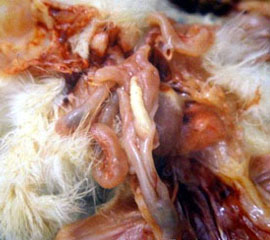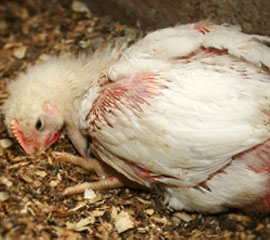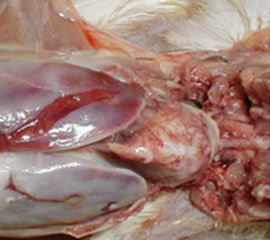 |
||||||||||||||||||||||||||||||||||||
|
||||||||||||||||||||||||||||||||||||
| DISEASES | ||||||||||||||||||||||||||||||||||||
| Back | ||||||||||||||||||||||||||||||||||||
General Signs of Disease
Specific signs of disease: 1. Respiratory Signs: gasping, coughing, snicking, swollen eyes, nasal discharge. Possible Diseases/Conditions Avian Influenza, Newcastle Disease, Infectious Laryngotracheitis, Infectious Bronchitis, Mycoplasmosis, Colibacillosis, Fowl Cholera, Ammonia in shed. 2. Nervous Signs: trembling, paralysis, recumbancy, circling. Possible Diseases/Conditions Marek’s Disease, Newcastle Disease, Fowl Cholera, Encephalomyelitis, Encephalomalacia (Vit. E/selenium deficiency), Aspergillosis, Botulism, Bacterial encephalitis. 3. Locomotor dysfunctions: crooked toes, swollen hocks, hyper‐extended or rubbery legs. Possible Diseases/Conditions Rickets (Ca/P/Vit. D3 deficiency or imbalance), Riboflavin deficiency, Biotin deficiency, Synovitis, Injury. 4. External signs skin, eye, leg, foot lesions. Possible Diseases/Conditions Lice, Mites, Biotin deficiency, Pantothenic acid deficiency, Riboflavin deficiency, Gangrenous dermatitis (Clostridium sp; Staph. aureus). 5. Gastro-intestinal tract dysfunction: skin, eye, leg, foot lesions. Possible Diseases/Conditions Coccidiosis, Necrotic enteritis, Coronaviral enteritis, Infectious Bursal Disease, Ulcerative enteritis, Paratyphoid (Salmonella spp.), Worms, Salt poisoning. 6. Stress: overcrowding, vaccination reaction, extreme temperatures, lack of feed or water. What to do if your birds look sick?
Always consider non‐infectious conditions (management factors or FLAWSS) first:
Use medications judiciously and only when necessary:
------------------------------------------------------------------------------------------------------------ Staphylococcus aureus Infection: Synonyms: Staphylococcosis- often associated with bumblefoot or omphalitis (navel ill). Cause: Staphylococcus aureus - Gram-positive coccus. Transmission: Ubiquitous on skin and in environment and must penetrate skin. Not directly transmitted from bird to bird. Clinical signs: Large variety of diseases: 1. Omphalitis (yolk sac infection), 2. Necrotic dermatitis 3. Necrotic skin lesions/abscesses, 4. Arthritis and tenosynovitis 5. Osteomyelitis (infection and inflammation of bone). Gross lesions Swelling on joints or footpad (bumblefoot); breast blister (yellow exudate in sternal bursa); dead chicks with swollen abdomen and crusted navel (omphalitis); osteomyelitis- yellow, necrotic plug in growth plate of bone. Differential diagnosis Pasteurellamultocida (fowl cholera) and Erysipelothrix (erysipelas). Prevention/Treatment: Reduce trauma in house - eliminate sharp objects, beak and toe trim, avoid wet litter or leaking drinkers; antibiotics (gram-positive spectrum such as erythromycin, streptomycin, tetracycline, etc.) may be useful during outbreak. Prevention is much more important than treatment.
Avian Pasteurellosis: Synonyms: Fowl Cholera Susceptible hosts: Pastuerellamultocida, a Gram negative, non motile, non-spore forming, rod shaped bacteria. Cause: Chickens, turkeys, ducks and geese are worst affected. Transmission: Bird to bird contact, ingestion of organisms, aerosols, insect bites, animal bites, transmission also present through fomites, and transmission by carrier birds. Clinical Findings: Large variety of diseases:
Drugs like sulphonamides, trimethoprim along with sulphasoxazole can be used effectively. Penicillin can be used parentrally against sulpha resistant flock. Prevention and control:Remove recovered birds from flock as they may act as carriers, do not introduce new birds without replacing new stock, the animals like dogs, cats, pigs should not be allowed to come near the farm, the cracks and crevices in the farm should be checked for mites and lice and their respective eggs, the flies should be removed from the farm, fowl cholera vaccine can be used. Vaccination:Inactivated killed vaccine to be administered in 2 repeat doses to chicken which are 8 weeks or older and repeat after 6 weeks.
Escherichia coli Infection (Colibacillosis): Synonyms: Escherichia coli infection; coligranuloma, colisepticemia. Cause: Escherichia coli, Gram-negative rod. Transmission: Birds infected by direct contact with dirty litter and hatchers or contaminated egg shells. This is an environmental disease. Not transmitted from bird to bird. Clinical Signs: Nonspecific and include ill-thrift, ruffled feathers, enlarged and swollen navel, decreased appetite, depression, diarrhea, pasting of feathers around vent. Gross Lesions: A variety of lesions depending on system that is affected:
Histopathology bacterial culture of affected organs is required for diagnosis. Treatment: E. coli isolates from commercial poultry are often resistant to a variety of antibiotics. This is compounded by the fact that few antibiotics are being put on the market for poultry. Enrofloxacin was effective against this organism, but the antibiotic was removed from food production use in 2006. Regardless, culture and sensitivity may assist treatment if more than one bird is affected. Prevention: Vigorous sanitation program in breeder house, at hatchery and at grow-out facility; Egg fumigation; dust control in house; routinely remove dead birds from house, avoid stress and immune-suppression (IBD).
Pullorum Disease: Synonyms: Bacillary White Diarrhea Cause: Salmonella pullorum. Transmission: primarily through the egg but may occur by other means such as:
Large variety of diseases:
Treatment is primarily a salvage operation and does not prevent birds from becoming carriers. Consequently, recovered flocks should not be kept for egg production. Antibiotics like sulphonamides, chlortetracyclines, sulphadimidine and trimethoprim combinations can be used for treatment. Prevention:Complete eradication is the only sound way to prevent pullorum disease. All hatchery supply flocks should be tested and only pullorum-free flocks used to pro¬duce hatching eggs.
Fowl Paratyphoid: Synonyms: Avian Salmonellosis Cause: Related to poultry, paratyphoid denotes the disease produced by any of the many Salmonella species other than S. pullorumand S. gallinarum. S. typhimuriumis the principle cause of the disease. . Transmission: Vertical and horizontal transmission present. Clinical Findings: Infection may result in acute or chronic disease. Acute clinical disease is common in young birds and rare in adult birds. The disease is of greatest economic concern to the turkey industry. Most acute paratyphoid infections occur in birds less than 4 weeks old, except in pigeons and canaries in which acute disease and high mortality may occur in any age group. Treatment: Proper use of drugs may reduce mortality in acute outbreaks of paratyphoid. No treatment is known that eliminates infection from the flock following an outbreak, and efforts to test and eliminate individuals harboring the organisms have been unsuccessful. Prevention is of primary importance. Regardless of treatment, infected birds should never be used to supply hatching eggs. However in acute cases, furazolidine @ 0.022% is effective.
Mycoplasma gallisepticum Infection (CRD): Synonyms: “Chronic respiratory disease” of chickens; MG, CRD. Cause: Mycoplasma gallisepticum. Transmission: Transovarian- transmitted from breeder birds to offspring through egg. Horizontal infection is through infected aerosols. Chronic respiratory disease of chickens is usually complicated by Escherichia coli infection, Newcastle disease virus or infectious bronchitis virus. . Clinical Findings: Chronic respiratory disease with coughing, sneezing (snicks), oculo-nasal discharge, poor feed conversion and air sac condemnations at processing. Diagnosis: History, gross necropsy, histopathology, serum plate agglutination test, culture or polymerase chain reaction. Gross lesions: Classic triad of fibrinous pericarditis, fibrinousperihepatitis and airsacculitis. Treatment: Usually does not eliminate infection and does not prevent egg transmission of infection. In small flocks the use of injectable tylosin might reduce the extent of clinical signs, but is not approved for birds in production (eggs or meat). For small breeder flocks it may be warranted to blood test for Mycoplasma gallisepticum (plate agglutination and hemagglutination inhibition tests) and eliminate the positive breeders from the flock. Prevention: Vaccination: chickens only, vaccine can kill turkeys (F strain); killed injectable (bacterin) or live spray vaccine (F strain or Mycovac L). Use and administration of vaccine by small flock owners can be problematic and can cause more problems than it solves because of potential for vaccine reactions.
|
||||||||||||||||||||||||||||||||||||
|
|
||||||||||||||||||||||||||||||||||||
| Back | ||||||||||||||||||||||||||||||||||||
|
||||||||||||||||||||||||||||||||||||
| Scroll | ||||||||||||||||||||||||||||||||||||
| Division of Veterinary and Animal Husbandry Extension Education Faculty of Veterinary Sciences and Animal Husbandry, R.S. Pura, SKUAST Jammu | ||||||||||||||||||||||||||||||||||||








